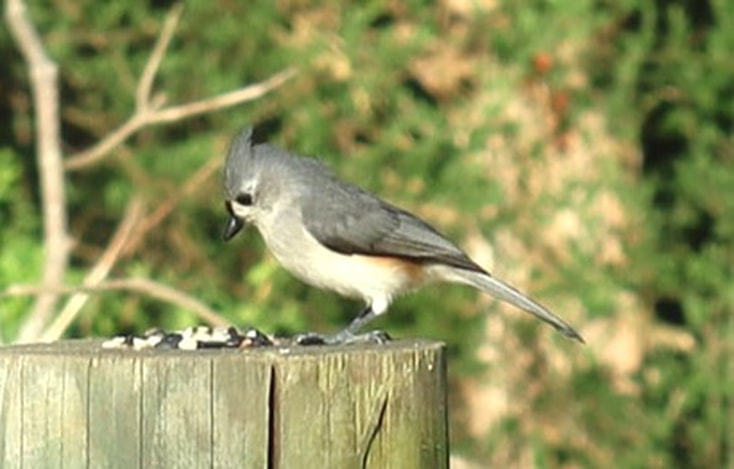|
Sycamore Grove Farm, Madison County
The “peter, peter, peter” call of the tufted titmouse (Baeolophus bicolor) is often the first bird song I hear when I go out each morning to journal the birds that I see and hear. We have titmice in the woods across the street, in the woods that line our farm and we also get them on a regular basis at our birdfeeder. Titmice are non-migratory so I may take them for granted during the excitement of the return of the birds that fly south for the winter. But their perky crested head and their comfort in being around people reminds me of how much I value these special birds on our farm. While you will often see titmice at your bird feeder, they have a broad diet, 2/3rd of which is insects. They have special muscles in their legs that allow them to hang upside down to feed – so they often see insect eggs under leaves where other birds cannot. They are known for storing food in bark crevices and are very good at remembering the location of their different caches. You will often see them foraging with other small birds, including chickadees, kinglets, brown creepers and nuthatches. After breeding season titmice will join flocks that include other small birds – a frequent technique used by many birds as a protection from hawks. In addition to birds of prey, titmice are hunted by snakes, raccoons, and opossums. One of their worst enemies are house cats, as titmice are very comfortable around people and are frequent birdfeeder visitors. Titmice line their nests with fur they have plucked from other animals, including raccoons, opossums, mice, woodchucks, squirrels, rabbits and livestock. While they mate for life, their life span is short, averaging 2.1 years. The oldest titmouse recorded by scientists was 13 years old. So please keep your cats inside – you may be saving the life of a titmouse and other birds as well! Update on bluebirds that successfully nested on our farm: One of our nest boxes had 4 eggs, of which three hatched. These three successfully fledged. I recently had the opportunity to see the male bluebird teaching one of the fledglings to “hawk” for insects. The male sat close to the fledgling on the top of a fencepost. The male swooped down, snatched a small insect, flew back to the post, and fed the insect to the fledgling. The adult then flew down again, returned and he ate the insect (apparently trying to show the fledgling how it was done). Then the adult flew away, followed by the fledgling. So, I don’t know when the fledgling got the point of the lesson. Happy birding! Charlene
0 Comments
Your comment will be posted after it is approved.
Leave a Reply. |
Have a blog or blog idea?
Let us know (click) Other Blogs
VA Native Plant Society - click Brenda Clement Jones - click John Muir Laws' Blog - click Megan's Nature Nook - click Categories
All
Archives
September 2023
Blog Administrator:
Kathleen A. VMN since 2018 |
